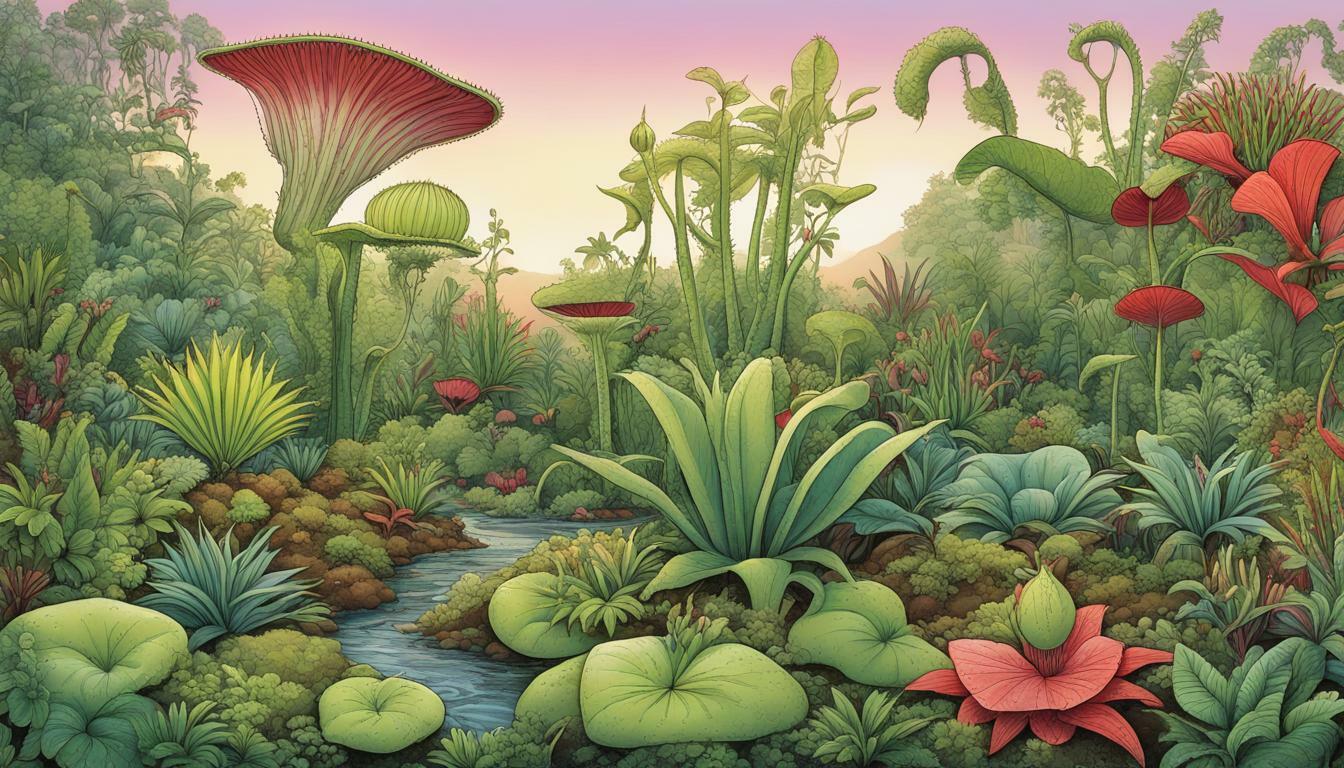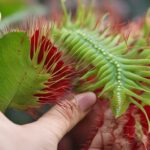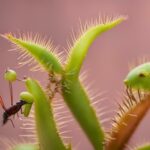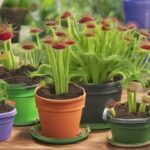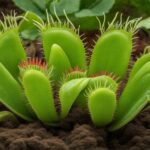Growing Venus Flytraps is a unique and rewarding experience, but many gardeners are hesitant to mix these carnivorous plants with other species. It’s a common perception that Venus Flytraps are difficult to grow alongside other plants, but with proper planning and care, it can be done successfully.
Key Takeaways:
- Venus Flytraps can be grown alongside other plants with proper planning and care.
- Understanding Venus Flytrap characteristics and needs is crucial for successful mixed plantings.
- Companion planting with Venus Flytraps can offer benefits like pest control and soil improvement.
Understanding Venus Flytrap Characteristics and Needs
When it comes to carnivorous plants, Venus Flytraps are a popular choice for many gardeners. However, their unique characteristics and specific care requirements can make growing them alongside other plants a challenge.
First and foremost, Venus Flytraps require plenty of sunlight to thrive. They should be placed in a location that gets at least six hours of direct sunlight each day. In terms of soil, they prefer a well-draining, acidic mix with a pH between 4.5 and 5.5. It’s also important to keep their soil consistently moist, but not waterlogged, to prevent their roots from drying out.
One of the most notable characteristics of Venus Flytraps is their carnivorous nature. They catch and digest insects and other small prey using their modified leaves, which form a trap when triggered by the movement of the prey. As such, it’s important not to fertilize Venus Flytraps with traditional plant food, as this can burn their traps and lead to long-term damage.
Another factor to consider when growing Venus Flytraps with other plants is their susceptibility to root disturbance. Their roots are shallow and sensitive, and can be easily damaged by other plants competing for space and nutrients. Therefore, it’s important to select compatible plant species that have a similar growth habit and water requirements.
By understanding the unique characteristics and needs of Venus Flytraps, you can better plan and prepare for growing them alongside other plants. With proper care and attention, these carnivorous wonders can thrive in a mixed planting environment.
Companion Planting with Venus Flytraps
Companion planting is an art, and with Venus Flytraps, it is essential to make the right choices for a successful planting. Some plant species are compatible with Venus Flytraps and can even enhance their growth. However, it is crucial to consider the needs of both plants in terms of watering, light, and soil nutrients, as well as their growth habits.
Carnivorous plant companions
When it comes to companion planting with Venus Flytraps, choosing other carnivorous plants is a good idea. They have the same growing conditions and are unlikely to compete for soil nutrients. Some suitable carnivorous plants to consider include Pitcher plants, Sundews, and Butterworts. These plants can create an attractive grouping, adding texture and color to your green space.
Aquatic companions
Since Venus Flytraps are semi-aquatic, plants that thrive in damp soil can make ideal companions. Examples of plants that grow well with Venus Flytraps are the Umbrella plant and the Water Hyacinth. Other options include ferns and mosses. These plants can also provide shade to the Venus Flytrap roots, keeping them cool and moist.
Non-invasive companions
When choosing companion plants for Venus Flytraps, it’s essential to avoid species that can become invasive or compete for resources. Be sure to consider the growth habit of compatible plants. The ideal plants are those that stay relatively small and don’t have aggressive root systems. Some examples of non-invasive plants that can grow well with Venus Flytraps are the African Violet and the Bromeliads.
With careful consideration and proper research, you can make the right choices when planting Venus Flytraps alongside other species. Choose suitable plants that will create a harmonious and thriving ecosystem.
Potential Challenges and Considerations
Growing Venus Flytraps alongside other plants can present several challenges that require attention to ensure the plants thrive. It’s imperative to consider the unique needs of each plant species to avoid overcrowding, nutrient competition, and pest problems.
Spacing
One of the most critical considerations when planting Venus Flytraps with other species is spacing. Overcrowding can lead to stunted growth and failed plantings. Therefore, it’s advisable to keep some space between the Venus Flytrap and other plants to avoid root competition, nutrient depletion, and moisture loss.
Soil Preparation
The soil also plays a vital role in the health and productivity of Venus Flytraps and their companion plants. When preparing the soil, ensure it’s well-draining and retains adequate moisture to support the different plant species. Additionally, the soil should have low nutrients since Venus Flytraps thrive in nutrient-poor environments.
Pest Management
Pests can be problematic when growing Venus Flytraps with other plants as they can affect both species. Aphids, spider mites, and thrips are common pests that attack Venus Flytraps and other plant species. Thus, it’s crucial to monitor the plants’ health and use appropriate pest management strategies to prevent infestation and protect the plants.
Creating Suitable Growing Conditions
Creating the right growing conditions is essential for healthy Venus Flytraps and compatible plant species. Here are some guidelines to ensure optimal conditions:
Soil pH
Venus Flytraps prefer a soil pH range of 4.5 to 5.5, which is acidic. To create an appropriate environment, use a soil mix that contains peat moss, sand, and perlite. These materials provide good drainage, aeration, and moisture retention for both Venus Flytraps and companion plants.
Moisture Levels
Venus Flytraps require consistently moist soil, but not waterlogged. Water them from the bottom by placing their pots in a tray of water, or use a spray bottle to mist the soil. For companion plants, select species that have similar water requirements to Venus Flytraps to avoid over or under watering.
Light Requirements
Venus Flytraps need at least 4-6 hours of direct sunlight per day, preferably in the morning or late afternoon. However, they can also thrive under filtered or artificial light. Choose companion plants that can tolerate sun or shade, depending on your growing conditions.
Overall, creating suitable growing conditions involves selecting compatible plants that have similar soil pH, moisture, and light requirements. With the right combination of species, you can create an attractive and thriving mixed planting with Venus Flytraps.
Selecting Compatible Plant Species
When it comes to gardening with Venus Flytraps, selecting compatible plant species is crucial to ensure healthy growth for all plants involved. The following plants have been identified as suitable companions for Venus Flytraps:
Sundews
Sundews, like Venus Flytraps, are carnivorous plants that thrive in similar soil and moisture conditions. They are also visually complementary, adding interest and variety to a carnivorous plant collection.
Pitcher Plants
Pitcher plants are another carnivorous option that can coexist with Venus Flytraps. They have similar light and moisture requirements and can also help control insect populations in the surrounding area.
Butterworts
Butterworts are non-carnivorous plants that perform well with Venus Flytraps. They prefer similar soil and moisture conditions and add a pop of color to a carnivorous plant display.
Spider Plants
Spider plants are non-carnivorous options that can withstand the carnivorous environment of Venus Flytraps. They prefer well-draining soil and can be a good option for adding vertical interest to a mixed planting.
Remember, when selecting companion plants for Venus Flytraps, it’s important to consider their growth habits and specific moisture, light, and soil requirements. With proper planning and care, you can create a thriving and visually appealing mixed planting featuring these unique and fascinating plants.
Maintenance and Care Tips
Now that you’ve successfully grown Venus Flytraps alongside other plants, it’s important to maintain their health and vitality. Here are some tips for keeping your mixed plantings thriving:
Pruning
Venus Flytraps only require minimal pruning to remove any dead or dying leaves. This will help the plant focus its energy on healthy growth and prevent the spread of disease. Use sharp, clean scissors to snip off any damaged or yellowing leaves as close to the base as possible.
Repotting
Venus Flytraps should be repotted every 2-3 years to ensure they have enough room to grow. When repotting, use a well-draining soil mixture that is slightly acidic (pH 4-5). Make sure the new pot is slightly larger than the previous one, and avoid burying the plant too deep.
Pest Control
While Venus Flytraps are carnivorous and can catch their own prey, they may still attract other insects. Watch out for pests like spider mites, aphids, and mealybugs, which can damage your plants. Use a mild insecticide or insecticidal soap to control infestations, and avoid using harsh chemicals that could harm your Venus Flytraps.
Observing Plant Behavior
Pay close attention to your Venus Flytraps and companion plants, as they will give you clues about how they’re doing. If your Venus Flytrap is not catching as many insects as usual or its leaves are turning brown, it may be a sign of stress or disease. Similarly, if your companion plants are wilting or not growing as well as before, they may be competing for resources with the Venus Flytrap. Be proactive and address any issues as soon as possible.
By following these maintenance and care tips, you can enjoy a healthy and vibrant mixed planting with your Venus Flytraps. Happy gardening!
Conclusion
In conclusion, growing Venus Flytraps alongside other plants is possible with proper planning and care. While it may be a common perception that Venus Flytraps are difficult to grow with other species, they can coexist harmoniously in a mixed planting environment.
To ensure successful growth, it is important to understand the unique characteristics and needs of Venus Flytraps. They require adequate sunlight, moisture, and soil conditions to thrive. Additionally, consider the growth habits, water requirements, and root competition of compatible plant species when selecting companion plants.
While there may be potential challenges in mixed plantings with Venus Flytraps, implementing spacing, soil preparation, and monitoring techniques can mitigate these concerns. Creating optimal growing conditions for both Venus Flytraps and compatible plant species is key to successful companion planting.
Experiment with Companion Plantings
We encourage you to experiment with companion plantings and share your experiences. With the right conditions and care, you can enjoy the beauty and benefits of a mixed planting environment that includes Venus Flytraps and other compatible plant species.
Remember, growing Venus Flytraps alongside other plants is possible with patience, attention, and a willingness to learn. Try it out today and see the potential for yourself. Can Venus Flytraps be grown alongside other plants? Absolutely!
Is it possible to grow Venus Flytraps in pots while also having other plants in the same pot?
Growing venus flytraps in pots can be challenging, especially when considering cohabitation with other plants. Although it is technically possible to have other plants in the same pot as Venus flytraps, it is not recommended. These carnivorous plants have specific soil and watering requirements, making it difficult to create an ideal environment for both them and other plants in the same pot.
FAQ
Q: Can Venus Flytraps be grown alongside other plants?
A: Yes, Venus Flytraps can be grown alongside other plants with proper planning and care.
Q: What are the characteristics and needs of Venus Flytraps?
A: Venus Flytraps are carnivorous plants with specific care requirements, including adequate sunlight, moisture, and soil conditions.
Q: What is companion planting with Venus Flytraps?
A: Companion planting refers to growing Venus Flytraps alongside compatible plant species to potential benefit both plants.
Q: What are the potential challenges of growing Venus Flytraps with other plants?
A: Challenges may include nutrient competition, overcrowding, and pest management, but these can be mitigated with proper spacing and monitoring.
Q: How can suitable growing conditions be created for Venus Flytraps in mixed plantings?
A: Guidelines include considering soil pH, moisture levels, and light requirements that accommodate both Venus Flytraps and compatible plant species.
Q: Which plant species are compatible with Venus Flytraps?
A: Compatible plant species include those with similar growth habits, moisture requirements, and ability to handle carnivorous plant environments.
Q: What maintenance and care tips are recommended for mixed plantings with Venus Flytraps?
A: Tips include pruning, repotting, and pest control, as well as observing plant behavior and addressing signs of stress or incompatibility.

